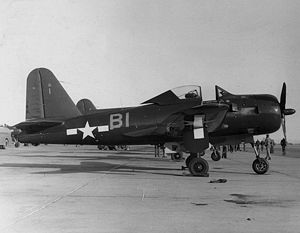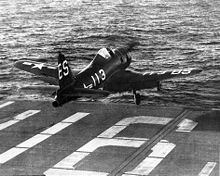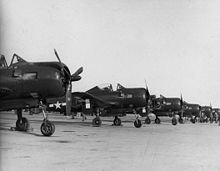Ryan FR Fireball Video - Overview
|
|
Ryan FR Fireball
FR-1 Fireball

Picture - An FR-1 Fireball of VF-66 at NAS North Island, 1945
Role: Fighter
Manufacturer: Ryan Aeronautical
First flight: 25 June 1944
Introduced: March 1945
Primary user: United States Navy
Produced: 1944-1945
Number built: 66
Variants: XF2R Dark Shark
The Ryan FR Fireball was a composite propeller and jet-powered aircraft designed by Ryan Aeronautical for the United States Navy during World War II. The FR-1 Fireball entered service before the end of the war, but did not see combat. The Fireball was the United States Navy's first aircraft with jet propulsion.
Design and development
Design began in 1943 to a proposal instigated by Admiral John S. McCain, Sr. for a composite-powered fighter predicated on the belief that early jet engines had sluggish acceleration that was considered unsafe and unsuitable for aircraft carrier takeoff and landing. Ryan aeronautical engineer Benjamin Tyler Salmon was tasked with designing an aircraft to meet these criteria. His solution was a composite design that allowed for conventional piston-powered flight but provided a jet engine for higher speeds.

Picture - FR-1 trials aboard USS Ranger, May 1945.
The first FR-1 prototype flew on 25 June 1944, but was lost in a crash at China Lake NAS in October that year. Investigation showed that the wing rivets were insufficiently strong, a problem cured by doubling the number of rivets, but not before the other two prototypes crashed in similar fashion.
The FR-1 Fireball was further developed into the XFR-2 which utilized a 1,500 hp (1,119 kW) Wright R-1820-74W in place of the -72W. One single airframe was converted to this configuration. No prototypes were built for the next proposed variant, the FR-3, which would use a General Electric I-20 turbojet. The fastest Fireball was the XFR-4, which had a Westinghouse J34 turbojet and was approximately 100 mph (161 km/h) faster than the FR-1. The final variant was the XF2R-1 Dark Shark, which replaced the piston engine with a General Electric XT31-GE-2 turboprop, but this never entered service, though a prototype was built. This prototype was used by Al Conover to set a new world altitude record for turboprop aircraft of 39,160 ft (11,936 m) on 2 May 1947.
Operational history

Picture - An FR-1 launching from USS Badoeng Strait, 1947.
Orders for 700 aircraft were placed, but only 66 were delivered before Japan's surrender. One squadron, VF-66, was equipped with the aircraft before war's end, but they never saw combat. On 6 November 1945, a Fireball became the first aircraft to land under jet power on an aircraft carrier, albeit unintentionally. After the radial engine of an FR-1 failed on final approach to the American escort carrier USS Wake Island, the pilot managed to start the jet engine and land, barely catching the last arrestor wire before hitting the ship's crash barrier.
The FR-1s were withdrawn in 1947, although development continued at Ryan but with the rapid advance in jet engine technology, the Navy decided to wait for more advanced aircraft to be developed.
Variants
XFR-1
Military designation of the Prototype Model 28 aircraft, three built.
FR-1 Fireball
Single-seat fighter aircraft, 66 built.
FR-2
Conversion with a Wright R-1820-74W replacing earlier piston engine, one aircraft modified.
FR-3
Proposed variant with a General Electric I-20 replacing earlier jet engine; never built.
XFR-4
Variant with Westinghouse J34; one built.
XF2R-1
Final variant with General Electric XT31-GE-2 turboprop replacing the piston engine; one built.
Operators

Picture - VF-66 planes at NAS North Island, 1945.
United States
United States Navy
The "Firebirds" squadron was known under three names:
VF-66 (May 1945 - October 1945)
VF-41 (October 1945 - mid-1947), redesignated VF-1E in November 1946
VRF-32
Survivors
Only a single example, FR-1, Bu. 39657 still survives. Deployed first to NASA Ames, the aircraft served as an instructional airframe at a technical school before being acquired by the Planes of Fame Air Museum at Chino, California in the 1960s. After restoration to static display condition, 39657 was rolled out at Chino on 13 June 2009.
Specifications (FR-1)
General characteristics
Crew: one
Length: 32 ft 4 in (12.19 m)
Wingspan: 40 ft 0 in (12.19 m)
Height: 13 ft 7¼ in (4.15 m)
Wing area: 275 ft² (25.6 m²)
Empty weight: 7,915 lb (3,590 kg)
Loaded weight: 10,595 lb (4,806 kg)
Powerplant:
1x— General Electric J31-GE-3 turbojet, 1,600 lbf (7.1 kN, 700 kgf)
1x— Wright R-1820-72W Cyclone radial engine, 1,350 hp (1,060 kW)
Performance
Maximum speed: 426 mph (only 275 mph with radial engine) (686 km/h (445 km/h))
Cruise speed: 153 mph (radial engine only) (246 km/h)
Range: 1,300 mi (2,100 km)
Service ceiling: 43,100 ft (13,137 m)
Rate of climb: 80 ft/s (24.4 m/s)
Armament
4 x— .50 in (12.7 mm) M2 Browning machine gun with 300 rpg
2 x— 1,000 lb (454 kg) bombs
8 x— 5 in (127 mm) rockets under wings
Related development
XF2R Dark Shark
Comparable aircraft
Caproni Campini Ca.183bis
Curtiss XF15C
Citations
Bibliography
Ginter, Steve. Ryan FR-1 Fireball and XF2R-1 Darkshark, Naval Fighters Number 28. Simi Valley, CA: Ginter Books, 1995. ISBN 0-942612-28-0.
Green, William. "Ryan FR-1 Fireball". 'War Planes of the Second World War, Volume Four: Fighters. London: Macdonald & Co. (Publishers) Ltd., 6th impression 1969, 1961, pp. 186-187. ISBN 0-356-01448-7.
Green, William and Gordon Swanborough. "Ryan FR-1 Fireball". WW2 Fact Files: US Navy and Marine Corps Fighters. London, UK: Macdonald and Jane's, 1976, pp. 66-68. ISBN 0-356-08222-9.
McDowell, Ernest. FR-1 Fireball (Mini in action number 5). Carrollton, TX: Squadron/Signal Publications Inc., 1995. ISBN 0-89747-344-2.
Ryan FR Fireball Pictures
More aircraft.
Source: WikiPedia